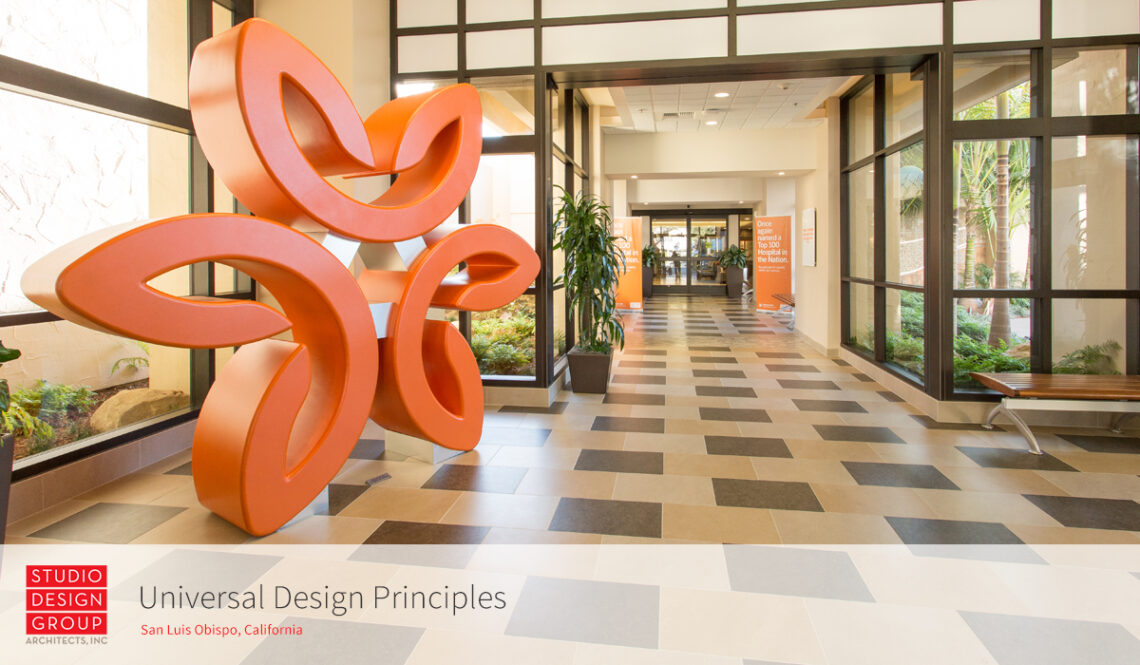
At Studio Design Group Architects, we believe that community design has the power to shape a more inclusive world. Mindfully incorporating universal design principles is a significant way we meet the needs of all end-users in the community spaces we create.
Today, it is estimated that one in five Americans live with a disability—that’s nearly 50 million people. It’s time to go above and beyond the wheelchair accessibility ramp and craft spaces for users of all abilities.
Created by a group of architects, engineers, product designers and researchers, the Principles of Universal Design provide a blueprint for a wide range of design disciplines including products, architecture, and communications. Our architects in San Luis Obispo are proud to embrace these seven principles in our community design projects.
The 7 Principles of Universal Design
From the Center for Universal Design, North Carolina State University
PRINCIPLE ONE: Equitable Use
“The design is useful and marketable to people with diverse abilities.”
This first principle is simply about providing an equal way for users to access features and facilities within a space. For example, making a staircase the only entrance to a room can segregate a group by their capabilities.
PRINCIPLE TWO: Flexibility in Use
“The design accommodates a wide range of individual preferences and abilities.”
Having flexible solutions for user adaptations is a key to good design. This principle is largely about giving end users a choice on how and where they access or use a space. This includes anything from customizable seating arrangements, multi-use rooms, and multiple entry/exit options.
PRINCIPLE THREE: Simple and Intuitive Use
“Use of the design is easy to understand, regardless of the user’s experience, knowledge, language skills, or current concentration level.”
Just as a product or app should be simple and intuitive to use, so should spaces. This is especially true for wayfinding. Facilities must be easy to navigate in order to be universally accessible.
PRINCIPLE FOUR: Perceptible Information
“The design communicates necessary information effectively to the user, regardless of ambient conditions or the user’s sensory abilities.”
As the name implies, it’s important for information to be perceptible to all users within a space. This involves using different modes (pictorial, verbal, tactile) to present essential information about a building, particularly in regards to navigation.
PRINCIPLE FIVE: Tolerance for Error
“The design minimizes hazards and the adverse consequences of accidental or unintended actions.”
This principle involves minimizing hazards to the fullest extent, taking into consideration the differing needs of users to the smallest detail. For example, ensuring flooring is suitable for those using assistive devices, and providing proper warnings of hazards and errors.
PRINCIPLE SIX: Low Physical Effort
“The design can be used efficiently and comfortably and with a minimum of fatigue.”
The principle of Low Physical Effort can be adapted in many ways, from allowing users to sit in a neutral body positive, to minimizing repetitive actions and sustained physical effort.
PRINCIPLE SEVEN: Size and Space for Approach and Use
“Appropriate size and space is provided for approach, reach, manipulation, and use regardless of user’s body size, posture, or mobility.”
When creating spaces, designs should provide adequate room for the use of assistive devices. Furthermore, a clear line of sight to important elements should be available for both seated and standing users.
Studio Design Group Architects are enthusiastic advocates of inclusivity. As community design experts, we believe that the Principles of Universal Design are fundamental to creating meaningful, functional spaces. To learn more about our community design efforts, reach out to one of our San Luis Obispo architects today online or at (805) 541-3848.
